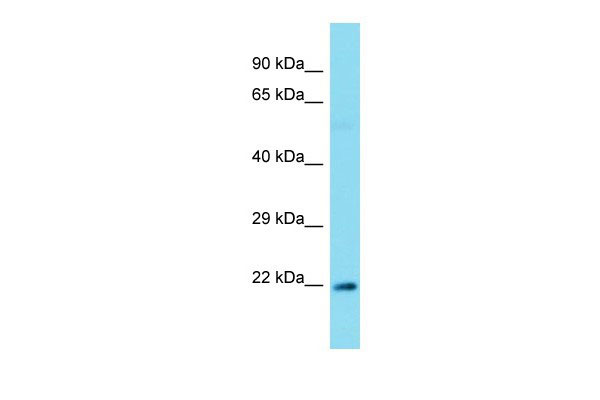CLDN4 Antibody - C-terminal region
Rabbit Polyclonal Antibody
- SPECIFICATION
- CITATIONS
- PROTOCOLS
- BACKGROUND

Application
| WB |
|---|---|
| Primary Accession | O14493 |
| Other Accession | O14493, NP_001296, NM_001305 |
| Reactivity | Human, Mouse, Rat, Rabbit, Pig, Dog, Guinea Pig, Horse, Sheep, Bovine |
| Predicted | Human, Mouse, Rat, Rabbit, Pig, Dog, Guinea Pig, Horse, Sheep, Bovine |
| Host | Rabbit |
| Clonality | Polyclonal |
| Calculated MW | 22 kDa |
| Gene ID | 1364 |
|---|---|
| Alias Symbol | CPE-R, CPER, CPETR, CPETR1, WBSCR8, hCPE-R |
| Other Names | Claudin-4, Clostridium perfringens enterotoxin receptor, CPE-R, CPE-receptor, Williams-Beuren syndrome chromosomal region 8 protein, CLDN4, CPER, CPETR1, WBSCR8 |
| Target/Specificity | This gene encodes an integral membrane protein, which belongs to the claudin family. The protein is a component of tight junction strands and may play a role in internal organ development and function during pre- and postnatal life. This gene is deleted in Williams-Beuren syndrome, a neurodevelopmental disorder affecting multiple systems. |
| Format | Liquid. Purified antibody supplied in 1x PBS buffer with 0.09% (w/v) sodium azide and 2% sucrose. |
| Reconstitution & Storage | Add 50 ul of distilled water. Final anti-CLDN4 antibody concentration is 1 mg/ml in PBS buffer with 2% sucrose. For longer periods of storage, store at -20°C. Avoid repeat freeze-thaw cycles. |
| Precautions | CLDN4 Antibody - C-terminal region is for research use only and not for use in diagnostic or therapeutic procedures. |
| Name | CLDN4 {ECO:0000303|PubMed:35773259, ECO:0000312|HGNC:HGNC:2046} |
|---|---|
| Function | Can associate with other claudins to regulate tight junction structural and functional strand dynamics (PubMed:35773259, PubMed:36008380). May coassemble with CLDN8 into tight junction strands containing anion-selective channels that convey paracellular chloride permeability in renal collecting ducts (By similarity) (PubMed:36008380). May integrate into CLDN3 strands to modulate localized tight junction barrier properties (PubMed:35773259, PubMed:36008380). May disrupt strand assembly of channel-forming CLDN2 and CLDN15 and inhibit cation conductance (PubMed:35773259, PubMed:36008380). Cannot form tight junction strands on its own (PubMed:35773259, PubMed:36008380). |
| Cellular Location | Cell junction, tight junction. Cell membrane; Multi-pass membrane protein |

Thousands of laboratories across the world have published research that depended on the performance of antibodies from Abcepta to advance their research. Check out links to articles that cite our products in major peer-reviewed journals, organized by research category.
info@abcepta.com, and receive a free "I Love Antibodies" mug.
Provided below are standard protocols that you may find useful for product applications.
Background
This is a rabbit polyclonal antibody against CLDN4. It was validated on Western Blot by Abgent. At Abgent we manufacture rabbit polyclonal antibodies on a large scale (200-1000 products/month) of high throughput manner. Our antibodies are peptide based and protein family oriented. We usually provide antibodies covering each member of a whole protein family of your interest. We also use our best efforts to provide you antibodies recognize various epitopes of a target protein. For availability of antibody needed for your experiment, please inquire (sales@abgent.com).
If you have used an Abcepta product and would like to share how it has performed, please click on the "Submit Review" button and provide the requested information. Our staff will examine and post your review and contact you if needed.
If you have any additional inquiries please email technical services at tech@abcepta.com.













 Foundational characteristics of cancer include proliferation, angiogenesis, migration, evasion of apoptosis, and cellular immortality. Find key markers for these cellular processes and antibodies to detect them.
Foundational characteristics of cancer include proliferation, angiogenesis, migration, evasion of apoptosis, and cellular immortality. Find key markers for these cellular processes and antibodies to detect them. The SUMOplot™ Analysis Program predicts and scores sumoylation sites in your protein. SUMOylation is a post-translational modification involved in various cellular processes, such as nuclear-cytosolic transport, transcriptional regulation, apoptosis, protein stability, response to stress, and progression through the cell cycle.
The SUMOplot™ Analysis Program predicts and scores sumoylation sites in your protein. SUMOylation is a post-translational modification involved in various cellular processes, such as nuclear-cytosolic transport, transcriptional regulation, apoptosis, protein stability, response to stress, and progression through the cell cycle. The Autophagy Receptor Motif Plotter predicts and scores autophagy receptor binding sites in your protein. Identifying proteins connected to this pathway is critical to understanding the role of autophagy in physiological as well as pathological processes such as development, differentiation, neurodegenerative diseases, stress, infection, and cancer.
The Autophagy Receptor Motif Plotter predicts and scores autophagy receptor binding sites in your protein. Identifying proteins connected to this pathway is critical to understanding the role of autophagy in physiological as well as pathological processes such as development, differentiation, neurodegenerative diseases, stress, infection, and cancer.


